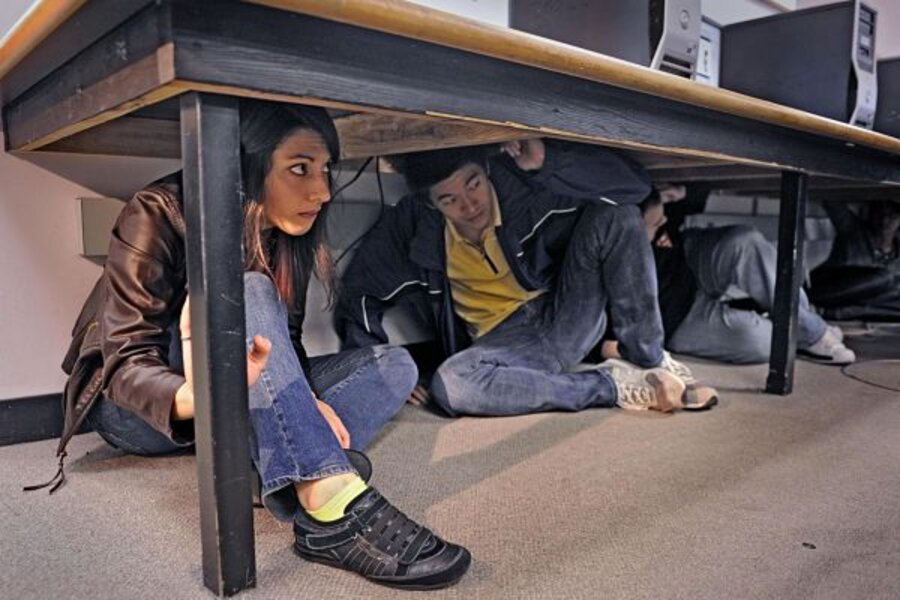Earthquake alerts: shake, rattle, and Twitter
Loading...
Earthquake scientists at the US Geological Survey are looking for ways to routinely use Twitter as an early source of information on a temblor.
What, you may ask? Twitter? That outlet for the banal in 140 characters or less? What value could that have for earthquake experts?
Geophysicist Paul Earle acknowledges that he was a bit skeptical of the idea, too. But there was no avoiding the fact that over the past couple of years, when an earthquake shook, Twitter tweeters were faster off the mark than the USGS in alerting the world that a quake had happened. The blogosphere was all over that discrepancy almost immediately, he told me during a phone chat, beginning with the disastrous quake in Wenchuan, China, in 2008.
IN PICTURES: Top Twitter moments
The comparison of the two systems, of course, is a bit unfair. The tweets often say nothing more than: OMG earthquake! Not a lot of information there to shape an emergency manager's response. When the USGS's email alerts go out on earthquakes worldwide, they contain much more information on the event -- magnitude, depth, location, for instance.
But, scientist that he is, Dr. Earle -- the operations director at the National Earthquake Information Center in Golden, Colo. -- said: Let's look at what Twitter can do and see if it can be useful. Those initial tweets could hold the potential to act as a "sanity check on what's going on," he says, giving seismologists an initial sense of how widely and intensely people felt the shaking. Tweets also could be a potential source of initial photos of damage and ground movement.
So, he turned a student working part time at the center loose on the task. He and colleagues set out their case study in the current issue of Electronic Seismology, a publication of the Seismological Society of America.
The team used a March 2009 earthquake in California as a test case. The quake's magnitude was 4.3. Searching Twitter, they pulled data on tweets from within about 120 miles from the earthquake's epicenter at Morgan Hill, Calif. The first tweet within that radius was posted 19 seconds after the event. Typically, formal alerts from regional and national seismic networks take from 1.5 to 20 minutes to hit the streets, depending on the location and magnitude of the quake.
Moreover, by taking advantage of Twitter's ability to gather information on a tweeter's location the team built a kind of shaking-intensity map based on the number of tweets posted from various places in the affected region.
The USGS already has a web-based mapping tool that residents can use to report the shaking, called Did You Feel It? But initial reports via Twitter beat out the initial DYFI entries by more than two minutes.
The study highlighted several challenges in using Twitter-based information. For instance, it was tough to tell an original tweet from a re-tweet. That could lead to a misleadingly high number of tweets from the quake area. The team also found tweets appearing at the same time as the Morgan Hill quake tweets, but they referred to computer games or ice-cream products with quake or earthquake in the name.
And location data came from the tweeter's online profile. The problem? Information from a New Yorker visiting the Bay Area and tweeting on the quake would look to the team as though the heads-up was coming from a quake that took place in New York. So the researchers had to find a away to spot and reject those miscues.
Since the study, however, Twitter has put original tweets and retweets on separate tracks, allowing a searcher to focus only on the originals. Moreover, the service now includes geographic coordinates in its tweet data, assuming a user is using a GPS-enabled cell phone or other mobile device and gives Twitter the OK to include those coordinates in its tweet database.
Earle's group is continuing to refine its use of twitter for early alerts, although the prototype system its developing is not ready for prime time publicly. And even if they prove useful as part of the USGS's formal alert system, they are no replacement for the kind of numerical information emergency mangers need to effectively respond to a quake.
Is there a real benefit to a system that can give folks at the Earthquake Information Center another minute or two's notice over a $200-million, high-tech global seismic network it relies on now?
Earle says yes. "As an earthquake responder, at the same time I would have received an email that had magnitudes and an epicenter for an earthquake, I'd have 100 short, personal accounts of what happened. Most of those will only say 'earthquake,' but others will say a little bit more." And once people know the USGS is taking this information vehicle seriously, they'll be more likely to exchange the one or two word tweet for something a bit more substantive, he says.
Given the big-buck investment in the global seismic network, "any time you can get an enhancement for the price of a part-time student, that's a pretty good deal," he says.





